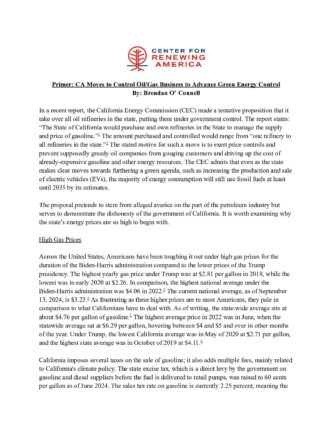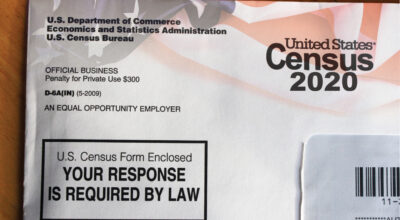
Primer: CA Moves to Control Oil/Gas Business to Advance Green Energy Control
In a recent report, the California Energy Commission (CEC) made a tentative proposition that it take over all oil refineries in the state, putting them under government control. The report states: “The State of California would purchase and own refineries in the State to manage the supply and price of gasoline.”1 The amount purchased and controlled would range from “one refinery to all refineries in the state.”2 The stated motive for such a move is to exert price controls and prevent supposedly greedy oil companies from gouging customers and driving up the cost of already-expensive gasoline and other energy resources. The CEC admits that even as the state makes clear moves towards furthering a green agenda, such as increasing the production and sale of electric vehicles (EVs), the majority of energy consumption will still use fossil fuels at least until 2035 by its estimates.
The proposal pretends to stem from alleged avarice on the part of the petroleum industry but serves to demonstrate the dishonesty of the government of California. It is worth examining why the state’s energy prices are so high to begin with.
High Gas Prices
Across the United States, Americans have been toughing it out under high gas prices for the duration of the Biden-Harris administration compared to the lower prices of the Trump presidency. The highest yearly gas price under Trump was at $2.81 per gallon in 2018, while the lowest was in early 2020 at $2.26. In comparison, the highest national average under the Biden-Harris administration was $4.06 in 2022.3 The current national average, as of September 13, 2024, is $3.23.4 As frustrating as these higher prices are to most Americans, they pale in comparison to what Californians have to deal with. As of writing, the state-wide average sits at about $4.76 per gallon of gasoline.5 The highest average price in 2022 was in June, when the statewide average sat at $6.29 per gallon, hovering between $4 and $5 and over in other months of the year. Under Trump, the lowest California average was in May of 2020 at $2.71 per gallon, and the highest state average was in October of 2019 at $4.11.6
California imposes several taxes on the sale of gasoline; it also adds multiple fees, mainly related to California’s climate policy. The state excise tax, which is a direct levy by the government on gasoline and diesel suppliers before the fuel is delivered to retail pumps, was raised to 60 cents per gallon as of June 2024. The sales tax rate on gasoline is currently 2.25 percent, meaning the consumer is paying about 8 cents in sales taxes per gallon of gasoline at the pump.7 The California Cap-and-Trade program adds approximately 30 cents per gallon of gas.8 The state’s Low Carbon Fuel Standard adds about 10 to 12 cents per gallon.9 As of August 12, 2024, taxes and fees (including federal excise) made up approximately $1.37 per gallon of gasoline to be paid by consumers at the pump.10
The State also mandates that a very specific type of fuel blend be used, unique to California. These blends of gasoline are known as CARB (California Air Resources Board). These blends are specialized to meet the state’s draconian environmental standards and are primarily engineered to reduce air pollution in the state. The number of refineries with the capacity to produce these blends is limited, further adding to the cost at the pump. As of the Fall of 2023, it was estimated that this blend requirement adds approximately 11 cents per gallon, with CARB estimating it may increase to as much as 47 cents per gallon in 2025.11
According to the Pacific Research Institute, if only the California policies affecting gas prices, such as fees and taxes for climate related matters and the strict fuel blend requirements, were struck down, Californians could save as much as $9.5 billion a year at the fuel pump.12 California’s GDP would potentially see a boost of 3 percent in annual growth and the state economy could grow by as much as $223 billion.13
California’s refinery capacity is limited due to these specialized requirements. If one or more of them go down due to maintenance issues this can lead to price spikes. California’s energy market is also relatively isolated. The geographic isolation and lack of pipelines connecting it to other parts of the country with energy resources limit its ability to import fuel from other regions of the country.
From January to June of 2022, gasoline prices saw massive hikes nationally as regular gasoline rose to an average of more than $4 a gallon. In California it was even worse, with the state average reaching more than $6 a gallon. In response to the Fall 2022 gasoline price spikes, California passed the Gas Price Gouging and Transparency Law (SBX1-2). Under the law, the CEC was granted additional, unprecedented authority to create and institute regulations over the transportation fuel market. The CEC’s Division of Petroleum Market Oversight has indefinite emergency powers to enact these regulations outside public notice. It passed a first regulation in February 2023, requiring all enterprises that consummate petroleum spot market transactions occurring in California to make extensive reports every day on the initiation and settlement of these transactions. Expectedly, prices spiked almost immediately thereafter, before eventually settling down by October.
Just this May, the CEC announced new regulations on importers of transportation fuels, imposing obligations on entities to file a “California Marine Import Report” before delivering to a California port. Comprehensive data regarding shipment and transportation details are required. Further, these reports are coupled with time limits, so that importers must actively track their shipments and dedicate time and resources to the effort. The CEC’s scheme of establishing rules for extensive data aggregation seems to be in anticipation of anti-gouging regulations being enacted soon, which will have a devastating impact on the energy production economies of California and that of nearby exporter states.
High Electricity Prices
A part of the higher price of electricity in the state of California is its large geographic size, population, and economy, which create difficulties in effectively transporting power to all parts of the state. Shifts towards green energy policies also drive up electric bills. Adding to the problem is an aging electrical grid in much need of refurbishment and updating, a problem that California shares with the country as a whole. The grid is running well beyond its limits, as it was designed with a few million residents in mind, not 40 million.14
Still, homeowners have seen their electric bills accelerate at rates far above that of the national average. The price per kilowatt-hour for California home residents as of August 2024 is 34.18 cents, while the national average was 16.43 cents. The overall price (including residences and business facilities) per kilowatt-hour in California is 26.37 cents while the nation as a whole is 12.60 cents.15 The average monthly electric bill in California currently sits at $386.16
Some residents have seen their monthly electric bills reach $1,000 and even higher. Residents of Borrego Springs in Northeastern San Diego County saw electric bills hit as high as $1,873.90 in June 2024, exceeding average monthly $1,200 rent and double compared to electric bills two summers previously.17 California is rebuilding infrastructure damaged by wildfires, involving spending billions in order to insulate wires and bury power lines. At the same time fossil fuels continue to be phased out and solar and other green energy sources are promoted. Recent heatwaves and the capital investments being made by utility companies raise prices, too, as all of the above expenses are passed onto customers paying for electricity.18
Time-of-use (TOU) plans may also drive up prices for many people. TOU plans charge more during periods of the day when demand is highest. In California this is typically between 4 and 9 p.m. Theoretically this is meant to encourage people to be more conscious of their energy consumption. It is supposed to monetarily reward people for their smart usage of power. But when heat waves hit certain parts of California, and when the hottest part of the day is in mid to late afternoon, it is no wonder why that is the period of highest demand. People are inside, using lighting and cooling technology, rather than spending time out in the heat.
Another reason for high prices are the de facto sanctions California imposes on external sources of electricity, which comprise about a third of its electricity consumption. By a large margin, it exceeds any other state in total electricity imports. However, despite these dependencies, California severely restricts energy acquisition from out-of-state facilities that do not fully comply with the CEC’s internal standards. In theory, this is supposed to encourage appropriation from cleaner, more efficient production facilities, but in practice, it significantly restricts the pool of available energy sources and, consequently, the overall cost to California consumers.
The latest regulation to drive up electric bills in California was the state legislature mandating that energy companies effectively charge a fee based on household income:
Under the plan, the state’s investor-owned utilities – Southern California Edison, San Diego Gas and Electric, and Pacific Gas and Electric – will be able to charge their customers a monthly fee regardless of how much power they consume. Most customers will pay $24 per month. Customers making under $62,200 per year, regardless of how much energy they consume, will pay less if they are eligible for other discounts. Low energy users who make above the $62,200 threshold will pay the most under the new plan.19
Californians could see an increase of as much as $300 a year as a result of this law. And multiple attempts to defeat or at least mitigate it have been blocked in the California Assembly.20
In summary: deteriorating infrastructure, grid-overload due to much higher population than in generations past, efforts to repair infrastructure offloaded onto taxpayers, the push for green energy, time-of-use and income adjusted electric plans, and sanctions and restrictions on imported power by the CEC all drive up the cost of energy astronomically for Californians.
Electric Vehicle Mandates
In 2020, Governor Gavin Newsom signed an executive order that all new passenger vehicle sales be zero-emission by the year 2035. The relentless push to increase the number of electric vehicles in California has been disastrous. There are not enough charging stations to keep pace with the amount of EVs in the state and the stations are not well positioned. These charging stations also do not work half the time or pose other difficulties to EV users. The vehicles are expensive to maintain and fix. A number of dealerships have protested Newsom’s draconian mandate in response to the many technical issues they are encountering with the vehicles, and Ford lost an average of $130,000 on every EV it sold in 2024’s first quarter.21
Worse still are the supply and demand problems created by the EV mandates. If Newsom’s mandates continue to be implemented then there could be over 13 million EVs on California roadways by 2035. A decade after this could see 22 million. But state electricity production will fall 21.1 percent short of the demand. Put another way, there would need to be a 21-fold boost to current electricity production, meaning 56,530 GWh needed by 2045.22
Potential State Control of Refineries
With supply and demand problems already evident, a proposal of state control of oil refineries by the California Energy Commission in order to implement price controls would only enlarge the problems. Basic economic sense says that if you try to set a price below what the free market would produce, a multitude of problems occur. Shortages of the resource are caused by a higher-than-expected demand. The quality of the product goes down due to less motivation and less money to maintain high quality. Such regulation will often lead to even more overregulation.23 All of these consequences of price controls lead in the end to more cost, though some forms are more indirect than others. As the Hoover Institution has noted, price controls and related shortages can increase the wait time for a product. During the gasoline shortages of the 1970s, wait times in line at the pump can be estimated to have made the real cost of price-controlled gas to be higher than what it would have been at free-market price:
During the 1979 gasoline line-ups, one would often line up for thirty minutes to get gasoline. Imagine that you wanted to buy ten gallons. At the time the regulated price was about $1 a gallon. But a reasonable estimate of the average time value of someone in line was about $8 an hour. So the true cost of the gasoline was not the $10 in money but $10 plus $4 in time, for a total of $14. That’s $1.40 per gallon.24
The price cap that had been set on gasoline by the Department of Energy during this crisis was $1.20.25
Conclusion
California’s regulatory overreach has resulted in rising prices in energy and smaller pools of dependable energy sources. The state’s politicians discriminate against average citizens by imposing flat rates on their electricity bills and refusing to expand energy infrastructure. Families and other middle-class workers are unable to afford basic amenities and are effectively driven out of the state. The government of California has yet to build the infrastructure necessary to achieve its zero-emission automobile mandates over the timeline it has established. Its legislature has also expanded the CEC’s ability to impose more regulations, stipulations, and bureaucratic processing onto energy providers. To counteract purported corporate greed, California lawmakers have made proposals to enact price-controls on energy into law, despite whatever fiscal ramifications that policy may have on an already strained industry.
Endnotes
- 1. Transportation Fuels Assessment: Policy Options for a Reliable Supply of Affordable and Safe Transportation Fuels in California | California Energy Commission p. 74
- 2. ibid.
- 3. Average Gasoline Prices Under The Past Four Presidents (forbes.com)
- 4. AAA Gas Prices
- 5. ibid.
- 6. California All Grades All Formulations Retail Gasoline Prices (Dollars per Gallon) (eia.gov)
- 7. https://www.cdtfa.ca.gov/taxes-and-fees/sales-tax-rates-for-fuels.htm
- 8. https://www.sfchronicle.com/climate/article/gas-price-rise-19459618.php#:~:text=OPIS%20estimated%20the%20cap%2Dand,to%20a%20gallon%20of%20gas.
- 9. https://www.eenews.net/articles/californians-already-pay-sky-high-pump-prices-it-might-get-much-worse/#:~:text=In%20recent%20months%2C%20the%20low,fuels’%20allowable%20greenhouse%20gas%20emissions.
- 10. https://www.energy.ca.gov/estimated-gasoline-price-breakdown-and-margins
- 11. https://factspergallon.com/#:~:text=According%20to%20the%20California%20Air,cents%20to%20every%20gallon%20sold.
- 12. Winegarden, Wayne. Rep. Legislating Energy Prosperity. Pacific Research Institute and Power the Future, May 2020. Pg. 7.
- 13. Ibid.
- 14. California’s ‘smart’ energy future glows on the horizon—but how to get there? – CalMatters
- 15. https://www.cnet.com/home/energy-and-utilities/heres-the-average-electric-bill-in-california-and-how-to-save/
- 16. https://www.energysage.com/local-data/electricity-cost/ca/#:~:text=Monthly%20electric%20bills%20are%20a,kWh%20*%2038%20%C2%A2%2FkWh.
- 17. Why Californians Have Some of the Highest Power Bills in the U.S. – WSJ
- 18. Ibid.
- 19. Jackson, Kerry and Anaya, Tim. The California Left Coast Survivor’s Guide: A Pacific Research Institute Handbook to Help the Rest of America Avoid Making a Wrong Left Turn. Pacific Research Institute, August 16, 2024. Pg. 45.
- 20. Ibid, 46.
- 21. California Left Coast… 47-58.
- 22. Ibid, 56.
- 23. Price Controls: Still A Bad Idea | Hoover Institution Price Controls: Still A Bad Idea
- 24. ibid25. Ibid.




